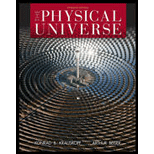
Concept explainers
The percentage of nitrogen by mass in each of the given compound has to be calculated.
Answer to Problem 19E
Percentage mass of nitrogen in urea is 47 percent.
Percentage mass of nitrogen in Ammonium nitrate is 35 percent.
Percentage mass of nitrogen in Ammonium sulfate is 21 percent.
Explanation of Solution
Mole of any elements is defined as “The amount of the element whose, mass in grams is equal to the
Avogadro’s number (
The product of total number of moles and the atomic mass of the substance gives the total mass of the substance.
Formula mass of urea (
Formula mass of Urea can be calculated as,
Therefore,
The percentage mass of nitrogen in urea is 47 percent.
Formula mass of ammonium nitrate (
Formula mass of Ammonium nitrate can be calculated as,
Therefore,
The percentage mass of nitrogen in ammonium nitrate is 35 percent.
Formula mass of ammonium sulfate (
Formula mass of Ammonium sulfate can be calculated as,
Therefore,
The percentage mass of nitrogen in ammonium sulfate is 21 percent.
Conclusion:
The percentage of nitrogen by mass in each of the given compound was calculated.
Want to see more full solutions like this?
Chapter 12 Solutions
The Physical Universe
- A capacitor with a capacitance of C = 5.95×10−5 F is charged by connecting it to a 12.5 −V battery. The capacitor is then disconnected from the battery and connected across an inductor with an inductance of L = 1.55 H . At the time 2.35×10−2 s after the connection to the inductor is made, what is the current in the inductor? At that time, how much electrical energy is stored in the inductor?arrow_forwardCan someone help me with this question. Thanks.arrow_forwardCan someone help me with this question. Thanks.arrow_forward
 An Introduction to Physical SciencePhysicsISBN:9781305079137Author:James Shipman, Jerry D. Wilson, Charles A. Higgins, Omar TorresPublisher:Cengage Learning
An Introduction to Physical SciencePhysicsISBN:9781305079137Author:James Shipman, Jerry D. Wilson, Charles A. Higgins, Omar TorresPublisher:Cengage Learning AstronomyPhysicsISBN:9781938168284Author:Andrew Fraknoi; David Morrison; Sidney C. WolffPublisher:OpenStax
AstronomyPhysicsISBN:9781938168284Author:Andrew Fraknoi; David Morrison; Sidney C. WolffPublisher:OpenStax University Physics Volume 1PhysicsISBN:9781938168277Author:William Moebs, Samuel J. Ling, Jeff SannyPublisher:OpenStax - Rice University
University Physics Volume 1PhysicsISBN:9781938168277Author:William Moebs, Samuel J. Ling, Jeff SannyPublisher:OpenStax - Rice University College PhysicsPhysicsISBN:9781305952300Author:Raymond A. Serway, Chris VuillePublisher:Cengage Learning
College PhysicsPhysicsISBN:9781305952300Author:Raymond A. Serway, Chris VuillePublisher:Cengage Learning Principles of Physics: A Calculus-Based TextPhysicsISBN:9781133104261Author:Raymond A. Serway, John W. JewettPublisher:Cengage Learning
Principles of Physics: A Calculus-Based TextPhysicsISBN:9781133104261Author:Raymond A. Serway, John W. JewettPublisher:Cengage Learning College PhysicsPhysicsISBN:9781285737027Author:Raymond A. Serway, Chris VuillePublisher:Cengage Learning
College PhysicsPhysicsISBN:9781285737027Author:Raymond A. Serway, Chris VuillePublisher:Cengage Learning





